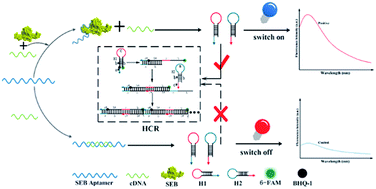Rapid detection of staphylococcal enterotoxin B in milk samples based on fluorescence hybridization chain reaction amplification
Abstract
A rapid, simple, and sensitive method has been developed to detect staphylococcal enterotoxin B (SEB). To establish the hybridization chain reaction-based aptasensor, we described the new probes of two hairpins (H1 and H2), which were first designed based on the partial complementary sequence of the SEB aptamer (cDNA). The H1 labeled with a fluorophore and a quencher can act as a molecular fluorescence “switch”. Hence, in the presence of SEB, the aptamer binds SEB, while the unbound cDNA triggers HCR to carry out the cyclic hybridization of H1 and H2 so as to turn “ON” the fluorescence through forming long nicked DNA. By using this new strategy, SEB can be sensitively detected within the range of 3.13 ng mL−1 to 100 ng mL−1 with a detection limit of 0.33 ng mL−1 (S/N = 3). Furthermore, the developed method could facilitate the detection of SEB effectively in milk samples.

- This article is part of the themed collection: Editors' collection: Food Engineering, Science, Technology, and Nutrition


 Please wait while we load your content...
Please wait while we load your content...